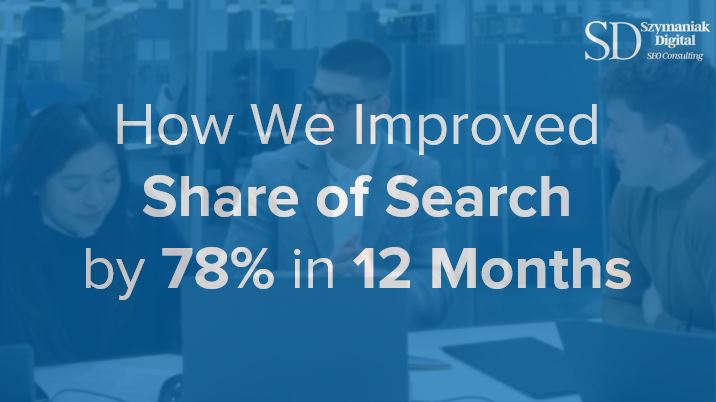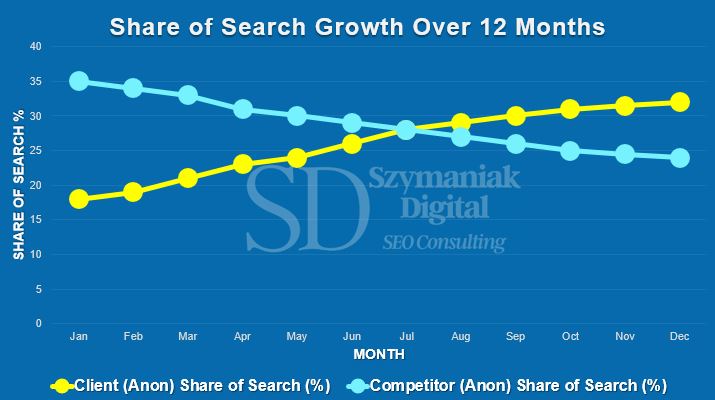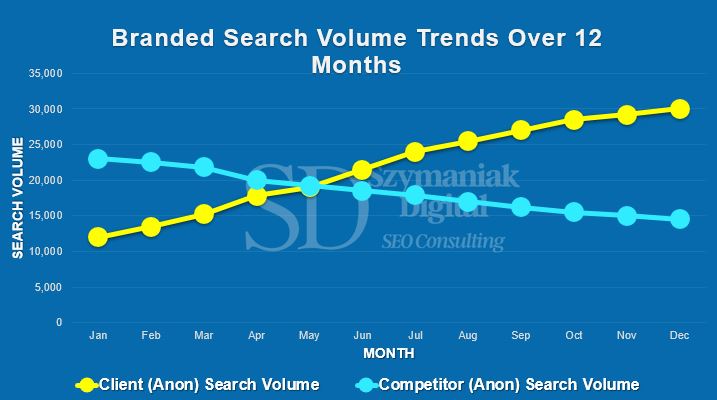How We Improved Share of Search by 78% in 12 Months
Share of Search (SoS) is one of the most powerful – but underutilised metrics in modern digital marketing. While market share measures revenue and share of voice tracks media presence, share of search reflects a more immediate and controllable form of brand awareness: how often people are actually looking for your brand compared to your competitors.

In this post, I’ll walk you through a real-world case study where we significantly improved a client’s Share of Search.
I’ll break down:
• What we started with
• The exact steps we took
• The outcomes
• Actionable advice for you to replicate this
What Was the Initial Share of Search?
When we started working with a leading UK-based e-commerce sportswear brand, they held 18% Share of Search in their category. This was significantly behind their top competitor, who was sitting comfortably at 35%.
What Steps Did We Take to Improve Share of Search?
Branded Search Analysis
We tracked branded search volume using SEO tools like SEMrush, benchmarking performance monthly against three top competitors.
SERP Domination Strategy
We optimised for branded visibility:
• Enhanced schema markup for sitelinks, logo, and social profiles
• Claimed and optimised the brand’s Google Knowledge Panel
• Monitored branded PPC bidding to protect brand queries from being poached
Surround Sound SEO
Using the Surround Sound SEO model, we made sure our brand appeared across multiple high-authority listicles and “best of” pages for category-level search terms like “best running shoes” and “affordable gym wear.”
Our goal was to create a “surround sound” effect, where our client brand’s presence is maximised across the SERP, making it appear as the go-to choice for a particular search query.
PR + Brand Mentions
We ran digital PR campaigns to secure placements on influential blogs, comparison sites, and lifestyle magazines – aiming to build both authority and brand name searches.
Influencer Collaborations & Social Amplification
We worked with fitness influencers and encouraged user-generated content. This helped amplify organic brand searches by creating conversations around the brand on Instagram, TikTok, and YouTube.
What Was the Outcome?
Over the course of 12 months, the brand’s Share of Search increased from 18% to 32% a 78% increase.
Meanwhile, their top competitor’s share dropped from 35% to 24%.

This directly correlated with a significant boost in branded search volume:
- Branded searches rose by 87% YoY
- Organic traffic to branded landing pages increased by 63%
- Conversion rates from organic traffic improved by 22%

We also saw significant improvements in SERP control – from 40% to 80% ownership of brand-related search features (featured snippets, sitelinks, and branded placements on category listicles).
Key Points to Improve Your Brand’s Share of Search
Audit Your Branded Search
Start with Google Trends and SEO tools to benchmark your brand’s search demand compared to competitors.
Own Your Brand SERP
Optimise your Knowledge Panel, sitelinks, and structured data. Ensure your homepage ranks #1 for your brand term.
Leverage Surround Sound SEO
Make sure your brand is mentioned on as many top-ranking listicles, product roundups, and review pages as possible.
Use PR to Drive Branded Queries
Secure mentions in online publications that show up for your commercial and informational keywords.
Monitor and Defend Branded PPC
Keep an eye on competitors bidding on your brand terms and run defensive PPC campaigns if necessary.
Final Thoughts on Share of Search
Share of Search is a leading indicator of market relevance. Unlike market share, which is slow to change, you can actively influence your SoS through content, PR, and smart SERP strategies.
If you’re not tracking it yet, now’s the time to start.
And if you’re already tracking it – ask yourself: Are you doing enough to improve it?
At Szymaniak Digital, we stay ahead of the curve, ensuring our clients capitalise on Share of Search developments for sustainable organic growth. If you’re looking for expert guidance in navigating these changes, let’s talk!

